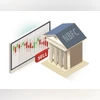)
ILLUSTRATION: AJAY MOHANTY
Non-Banking Financial Companies (NBFCs) are expected to face challenges related to funding availability, which could slow their growth compared to the strong expansion seen in the past two financial years, according to a report by ICRA.
The growth of NBFCs’ assets under management (AUM) is expected to moderate to 13–15 per cent in the current financial year, down from 18 per cent in the previous financial year, the report said.
A key challenge in meeting growth expectations will be securing the necessary debt funding, in addition to refinancing existing debt. The estimated incremental debt funding required for AUM expansion in FY25 is projected to be between Rs 5.6 trillion and Rs 6 trillion, the report said. Despite the substantial demand and unmet credit needs, the risk of slower NBFC AUM growth could increase significantly if the tight funding conditions observed in the first quarter of the current financial year persist throughout the financial year.
The report said that the sector’s AUM, which stood at approximately Rs 47 trillion in March 2024, is projected to exceed Rs 50 trillion in the current financial year.
The overall loan quality of retail assets held by NBFCs, excluding housing finance companies, is expected to fall by 30–50 basis points in the current financial year. The sector’s profitability is likely to be affected by elevated funding costs, increased competition from banks, slowing growth, and asset quality challenges. The report said that the sector’s margins will decline by 25–45 basis points compared to the previous year.
Meanwhile, AM Karthik, senior vice president and co-group head of financial sector ratings at ICRA, noted that the sector’s best days for non-performing assets (NPAs) are likely over, with delinquencies expected to rise.
ICRA highlighted that slower growth, coupled with portfolio seasoning following the rapid credit expansion in the retail asset segments over the past two financial years, will begin to impact asset quality this year. Additionally, concerns about overleveraging and the growing share of unsecured loans are expected to heighten credit risk, posing an increased threat to loan quality in the sector.
First Published: Aug 21 2024 | 5:23 PM IST


































